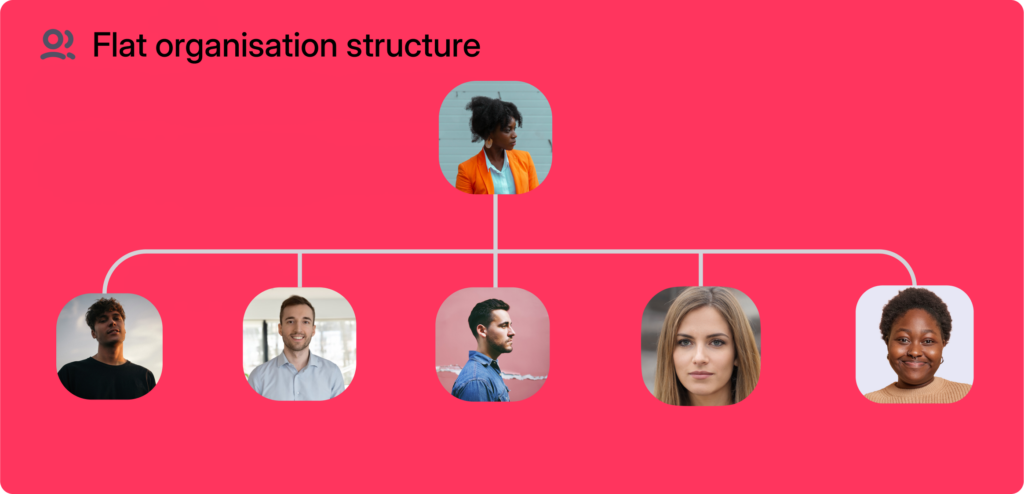A flatter organisational structure is about empowering teams with fewer management layers. This streamlined approach can lead to quicker decision-making and enhanced team collaboration.
Here, we’ll help you understand the fundamentals and practicalities of adopting a flatter structure, providing actionable insights from successful business case studies of flatter organisations.
What are Flatter Organisational Structures?
Unlike traditional hierarchies, flat structures have fewer management levels, allowing for a more direct line of communication between employees and higher-level managers. This is intended to make decision-making more efficient and enable faster responses within and between teams – less bottlenecks, essentially.
But a flatter structure doesn’t just reduce levels; it also enhances responsibilities as employees are more likely to feel involved in the decision-making processes, leading to increased engagement at work. Never underestimate the power of feeling like your voice is being heard!
A flat organisational structure is not defined by what it lacks but by what it enables. In contrast to a tall organisational structure, the absence of middle management and a short chain of command are just the tip of the iceberg. The true strength of a flat management structure is its capacity to cultivate autonomy and responsibility within its workforce.
In a flat structure, employees aren’t confined to their job titles to the same degree; they are empowered to take on a broader range of tasks and make decisions that have a greater impact, giving people a sense of ownership and connecting them to the company more closely.
Flat vs. Hierarchical Structures
A traditional hierarchical structure, often called a tall organisation, resembles a tower, with each floor symbolising a different management level. The further you ascend, the more specialised your role grows. But in a flat organisation, this traditional hierarchical structure is replaced by a single floor where everyone collaborates, allowing for more open communication and fostering a culture of creativity.
Advantages of a Flat Organisational Structure
Transitioning to a flatter structure is not just about changing the org chart; it’s about making a strategic decision that can benefit your business’s bottom line. There are many advantages of reducing hierarchy and adopting a flatter organisational structure, such as:
- Communicate more directly with different roles, promoting better relationships and a more cohesive team spirit
- Enhance collaboration – both between and within teams!
- Simplify and speed up the decision-making process
Not only this, but flat structures enable businesses to:
- Adjust more quickly to changing market conditions
- Provide employees with greater job satisfaction due to increased autonomy
- Reduce operational costs (and bottlenecks) by eliminating middle management positions
There are plenty more benefits of a flat organisational structure, including the following:
1. Flat Structures Build Communication Bridges
One of the most significant benefits of a flatter hierarchy is improving direct communication. This structure facilitates a more open dialogue between employees, management, and leadership, resulting in more effective collaboration and increased productivity.
It’s common sense, really; being able to speak directly to any team member without fear of overstepping within the chain of command can only mean more valuable conversations are had and less time is wasted in having them!
2. Flat Structures Enable Quicker Reactions
Flat organisations, thanks to their reduced layers of management and increased autonomy, are inherently more flexible and adaptable. This enables them to:
- Respond swiftly to market changes
- Make quick decisions
- Implement changes more efficiently
- Foster innovation and creativity
- Empower employees to take ownership and initiative
New ideas and risk-taking are encouraged as employees are not confined to specific roles or departments. This agile learning culture is integral to growing organisations with flat structures, where the use of AI and technology now supports quick adaptation to new situations and facilitates knowledge-sharing across the company.
3. Flat Structures (Usually) Cut Costs
There are a couple of reasons for this one.
Firstly, as we’ve mentioned, flat structures drive a sense of ownership and, therefore, engagement as employees feel more connected to a company they have a say in. This in itself is an exercise in cost-saving, as research by Gallup revealed that disengaged employees are costing the UK a whopping £87.2 billion in lost productivity. Find strategies to engage the, such as implementing a flatter hierarchy, and you could minimise this figure.
Adopting a flat organisational structure can also lead to significant cost savings in terms of headcount, as reducing the necessity for middle management positions substantially cuts workforce costs. This results in lower compensation expenses, which are often a significant part of gross revenue.
Disadvantages of a Flat Business Structure
Those advantages may sound compelling, but there is another side of the coin to consider here. These are a few of the main cons:
1. Flatter Hierarchies Can Muddy the Waters
In a flat organisational structure, the lack of distinct reporting lines and vague roles can result in confusion among teams. For instance, an employee may have several supervisors or have such a varied role that lines of responsibility become blurred. This kind of clarity is key to accountability and, therefore, quality output.
With this kind of uncertainty comes an imbalance in workload, too, as employees may risk taking on too much without clear lines drawn in the sand. This can eventually leave to burnout and reduced retention rate.
2. Flatter Hierarchies Cause Progression Roadblocks
Career advancement is a major motivator for many employees, but the route to advancement might not be as clear-cut in a flat company structure. This can lead to a perception of stunted career growth or a lack of clear career paths, which could deter potential employees and lead to higher turnover rates.
A Gallup poll revealed that almost 90% of millennials prioritise “professional or career growth and development opportunities” as extremely important elements of a job, and a Pew Research Center survey highlighted that 63% of people cited the lack of advancement opportunities as the main reason for quitting jobs.
Flat structures are at a greater risk of turnover related to this. Employees may take on more responsibility but not see concrete career progression examples, such as a changing job title or hierarchical rank.
3. Flat Hierarchies Don’t Always Balance Autonomy With Support
While autonomy is a distinguishing feature of flat organisational structures, it is vital to balance it with sufficient support and training so that employees aren’t at risk of burning out or leaving. Employees who are given more responsibility need to understand what is expected of them and have the skills and knowledge to fulfil these expectations competently.
A living organisational story that reflects the company’s values and identity encourages a culture of self-direction and autonomy as the corporation expands. Continuous learning and development initiatives allow employees to cultivate a growth mindset, which is crucial for managing the freedoms afforded by a flat organisational structure.
Implementing a Flatter Organisational Structure: Best Practices
Moving from a hierarchical to a flat organisation involves a process known as ‘delayering’, which means removing unnecessary levels of management, making the organisation more agile and adaptable. Here are some best practices to guide you through the process:
1. Establish a Central Hub
This should provide a source of information, automate tasks, and enable direct communication for all employees. Then, as the organisation scales up, it can maintain a flat structure by dividing into smaller, autonomous modules or ‘tribes’. This helps to sustain agility and flexibility.
Maintaining the company’s spirit and values during expansion is vital, which can be achieved through storytelling that strengthens a shared identity and communicates the evolving corporate narrative. Employees might require training to bridge skill gaps or enhance self-management capabilities, which is important when transitioning to roles with more autonomy.
2. Outline Clear Roles and Expectations
In a flat organizational structure, emphasising autonomy, defining clear roles and providing sufficient training are incredibly important. Providing comprehensive policies, procedures, and processes helps employees understand expectations and thrive in their roles within a flat structure.
3. Foster a Culture of Feedback and Support
Cultivating a culture of feedback and support is integral in a flat organisational structure. Trusting employees to make decisions and take responsibility for their work within the framework of clear goals, expectations, and guidelines is crucial.
When leadership roles are redefined to focus on facilitating collaboration and supporting employee development, empowering employees becomes a natural outcome. Plue, regular feedback sessions encourage a culture of continuous improvement and help the organization remain flexible and responsive to changes.
4. Monitor and Adjust as Necessary
Regular evaluation and adaptation of the flat organisational structure, communication channels, and collaboration processes are necessary to guarantee the structure’s effectiveness. Implementing regular performance reviews is a practical method for monitoring how well a flat organisational structure functions.
The use of KPIs that align with the company’s strategic objectives serves as a barometer for assessing individual performance and the overall efficacy of the flat organisational model. Conducting employee satisfaction surveys can shed light on the impacts of the flat structure on staff morale and productivity, signalling when and where adjustments need to be made.
Create a Digital Org Chart with Factorial
Implementing structural change in an organisation can be tough, especially when it comes to communicating it. The easiest, clearest way to explain a new company structure is by using an org chart. Using Factorial’s org chart software to create your chart allows you to keep a working document you can update as soon as roles change within the business. It allows for:
- Real-time updates when someone leaves or joins the company.
- Flexible visual representation, depending on your preferred format.
- Transparency for your whole team and greater cross-team collaboration.
Find out how it works with a free demo!
Flatter Organizational Structures FAQs
What is flat type structure?
A flat organisational structure has few or no levels of middle management between leadership and employees, and is often seen in small organisations or startups due to their size and management needs. This type of structure promotes more communication and collaboration among employees.
What is taller vs flatter organisation?
A tall organisational structure is more hierarchical with a narrow span of control, while a flat organisational structure features a larger span of control and requires higher autonomy.
What are the 4 types of organisational structures?
The 4 types of organisational structures are functional, divisional, matrix, and hybrid, each with its own strengths and weaknesses. Consider factors such as business goals, industry, and company culture when deciding which type is best for your organisation.
What are the key benefits of a flatter organisational structure?
A flatter organisational structure offers higher visibility, better communication, faster decision-making, promotes autonomy, and increases agility for everyone in the organisation. This kind of structure allows for greater interaction and quicker responses to changes in the business environment.
What are the potential drawbacks of a flatter organisational structure?
The potential drawbacks of a flatter organisational structure include ambiguity in roles, limited career progression opportunities, and the challenge of balancing employee autonomy with the right level of support. It’s important to consider these factors when implementing this type of structure carefully.






